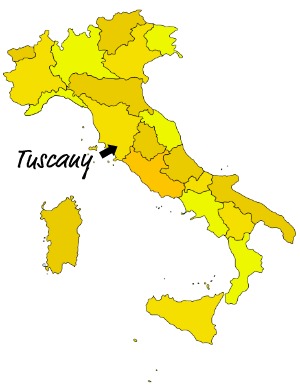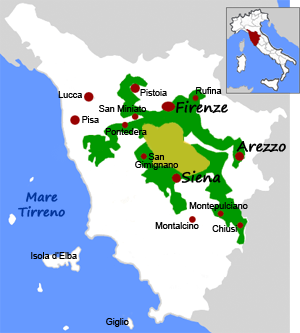 Luckily, Tuscany is located right in the Chianti region offering many different wines (mainly reds). In fact, there's only one region in Italy that has more D.O.C.G. zones than Tuscany, being Piedmont.
Luckily, Tuscany is located right in the Chianti region offering many different wines (mainly reds). In fact, there's only one region in Italy that has more D.O.C.G. zones than Tuscany, being Piedmont.Tuscany has many famous great wines (in which we'll get into later) but it also has a small, yet great, contribution to the white wine world. For example, the Galestro uses trebbiano grapes due to the high reproduction and it's disease resistance made up of high acidity. On the contrary, it offers little aroma and fruit extraction when being pressed. However, the trebbiano is not the only white grape variety that is offered...there is also the vernaccia, which is one of Tuscany's most historic whites. In fact, it became Italy's first D.O.C. in 1966, and then later became a D.O.C.G. in 1993. These grapes are usually more floral and crisp with an almond after-taste, but similar to the trebbiano, there isn't much aroma. Let me give you an example:
Although I have not had this wine, the Bellini family produces great wine. This is the Bellini Vernaccia San Gimignano. And lucky for you Baltimore readers, it's easily accessible at Beltway Fine Wine & Spirits. Keep in mind that this is a wine that is to be consumed with pasta with light flavor, maybe appetizers, but nothing red. It's going to have a crisp flavor, fruity, light, and delicate. If you have an strong-flavored dishes, this is not the wine to consume it with. Probably good with white meat like chicken.
Now, moving on to the red wines of Tuscany (my favorite)! Probably the most famous red grape variety is the sangiovese. Although there are many different names for this grape variety, there are only two basic categories being: Sangiovese Gross and Sangiovito. Usually this grape gives off almost a black-cherry like flavor and can be seen in Chianti, Brunello di Montalcino, and Classio. The Chianti region is located mainly between Florence and Siena taking up more than 42,000 acres of land, of which 17,000 acres of that is the original Classico region (Yellow section on map).
Now, I listed a good Chianti Classico in which I had here over in Florence, being Antinori Peppoli Chianti Classico. I'll be describing what I had (being a 2009)Let me give you a little run-down on my tasting and analysis of this wine (if you don't like reds, at least try this):
- Color: A red-garnet that is deep are rich around the nail (outside when bent)
- Viscocity: Very thick with wonderful drops of glycerol down the side of the glass.
- Olfactics: Secondary aromas: Not so woody or grapey, more cooked fruits and a little flowery.
- Taste: Nice and fresh with a woody linger and aftertaste
- Notes: This is wine that's good for the whole meal. It would be better with red meat, but not fish. However, keep in mind that this is good for middle aging (being 4-7 years).
To get a truely authentic Chianti Classico, you need to look for the Black Rooster symbol that looks a little something like this:
When you purchase a Chianti Classico, you should be getting a darker, more fuller and dense wine compared to your standard red wines.
I guess I can talk about Italian (or at least Tuscan) dessert wines (vini dolci). For those of you who have a little bit of a sweet tooth, you might want to do a little bit of searching for Vin Santo. This wine is usually between 16% - 18%! This golden dessert wine is made with caramel to give it a nice reflection with almost a honey-like taste with almonds, vanilla, and honey. Very, VERY, sweet. Keep in mind that this is a drink that must be consumed slowly with small sips and biscotti. Tuscans (or Italians) dip biscotti into this drink to let it absorb, in which they consume. Think of it as a grown-up version of dipping your oreo cookies into a nice tall glass of milk...
Oh yeah, I come home in 15 days! I'll soon be posting a few final blog posts that are reflections on my experience studying abroad here in Florence, Italy. Thank you for reading!


No comments:
Post a Comment